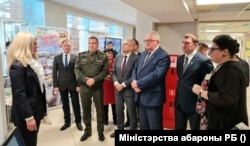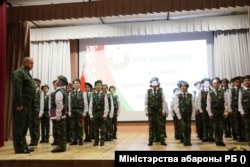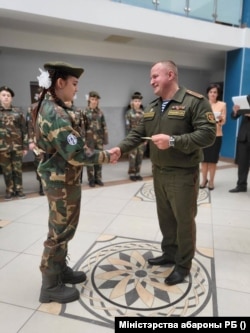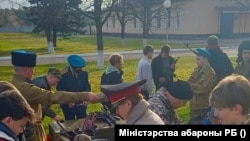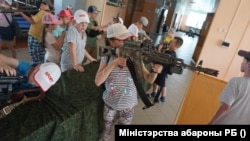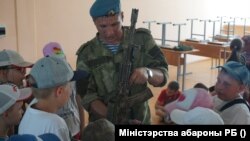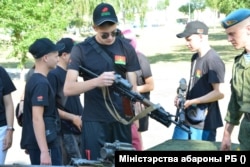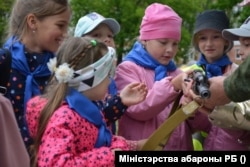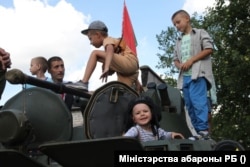In August 2020, Belarus teetered on the brink of revolution as massive, national opposition protests rose up to challenge strongman leader Alyaksandr Lukashenka. Belarusians refused to accept the official result of an election that millions believe was stolen.
Thousands were detained, and many reported torture or abuse at the hands of the authorities. Several people died during the crackdown
In an apparent bid to head off another such scenario in the future and turn Belarusian children into "patriots," the authorities have begun to take "military-patriotic" education seriously. Summer camps are organized under the supervision of the security forces. Since the beginning of the academic year, almost 20 "military-patriotic" clubs have been created for schoolchildren, and the position of a special "military-patriotic" educator has been introduced in schools.
"Any dictatorial regime plans to exist forever. In any case, it seeks to guarantee its status for decades to come," says Valer Karbalevich, a political commentator for RFE/RL's Belarus Service. "That is why the authorities pay such attention to the education of the younger generation."
Karpyankou's Clubs
Such "military-patriotic" clubs existed before, but after the protests in 2020, the authorities decided to focus on the education of young Belarusians even more thoroughly. In May, Lukashenka signed a law on the development of these clubs and their financing from the budget.
The law states that the clubs were created by the decision of Deputy Interior Minister Mikalay Karpyankou. This is the same Karpyankou who became widely known after he broke the glass door of a Minsk cafe with a baton on September 6, 2020, in order to detain protesters from a nearby opposition rally.
Later, Karpyankou publicly called the opposition abroad "mad dogs who deserve only one thing -- death."
Clubs for children and young people in Karpyankou's plan are created on the basis of military units, the Interior Ministry, the Defense Ministry, and the Border Committee, and "preserve the best experience of military-patriotic education from the time of the U.S.S.R." The authorities boast that there are so many people who want to join the clubs that parents even file complaints that their children can't get in. However, in the spring, the state news agency BelTA news agency reported that only about 1,000 children had joined military-patriotic clubs.
'You Reap What You Sow'
Their creators claim that the purpose of the clubs is to instill positive thinking, an idea of citizenship, a sense of patriotism, loyalty to the motherland, and a readiness to perform tasks in defense of the motherland in children and young people.
Another goal is also often mentioned: to prepare future soldiers.
In April, representatives of the Interior and Defense ministries held a press conference to elaborate on how the clubs worked. The deputy commander of the ideology unit of the Interior Ministry, Lieutenant Colonel Alyaksandr Brazhytski, voiced the goal at that time:
"Inculcate love for the flag, for the anthem. You reap what you sow. We have the best youth. Clean, bright; this is our future. And they absorb everything so much, and say that they don't want anything.... We adults don't want to deal with them. Like, the street will bring them up. Yes, the street will raise them. We remember the year 2020, and they will go in a completely different direction, unlike us."
Former Education Minister Ihar Karpenka, who actively supported the creation of these clubs in 2021, said they help to "detach" young people from gadgets and protect them from destructive influences.
Training Young Soldiers
Military-patriotic clubs operate on the basis of military units. For example, military unit 3214 (the same one whose soldiers took an active role in violence against peaceful protesters) operates the Lynx Club, which is attended by more than 100 children.
Another example is the Granite Club, which is held on the base of military unit 5448. There, children engage in gymnastics and hand-to-hand combat -- pre-conscription training.
Children are taught to use weapons. They are taken to clean up the "Stalin Line" --fortifications along the western border of the Soviet Union built in the 1920s. They celebrate Victory Day on May 9 and hold meetings with Orthodox priests.
Every year, on the eve of the Day of Special Intelligence, the 5th Separate Special Purpose Brigade holds the Young Special Forces competition. Children are introduced to various types of firearms and are also allowed to practice shooting with an air rifle.
Summers At A Military Base
This approach to education is also applied at children's sports and patriotic camps. In 2021, there were 46 such camps and 60 this year. Children could visit the military units for hours, and even stay overnight.
In 2021, 2,000 children visited military bases. For example, students from Vitebsk visited the 103rd Vitebsk Separate Guards Airborne Brigade in the summer. Almost 300 schoolchildren attended classes at the airborne complex, familiarized themselves with the main models of the brigade's small arms, the history of the airborne unit, fired a machine gun on an electronic simulator, and watched a concert by a military band and a film about the combat path of a military unit.
Children are also taken on various excursions. In July, students of the Giant military-patriotic club, along with representatives of the Patriots of Belarus organization, visited the 38th Brest Separate Guards Assault Brigade.
In just two weeks in June, the unit was supposedly visited by more than 10,000 children.
At such contests, schoolchildren compete in military training: disassembling and assembling a machine gun, packing a duffel bag and equipment, unloading a magazine, throwing a training grenade, providing first aid, and marksmanship.
During summer camps, military units organize exhibitions of military equipment for children. One of them took place at the 6th Separate Guards Mechanized Brigade, where an exhibition of weapons and military equipment was organized in the city of Zhabinka.
Military Teachers At School
"Correct patriotism" must now be addressed more seriously in schools, as well. Last year, the position of head of military-patriotic education was introduced. There is no single approach in the work of such teachers yet; they only recently started to prepare a manual. While there is no textbook, the Defense Ministry recommends using supporting materials on its website.
The first lesson is: "Falsification of historical memory: to whom and why is neo-fascism is beneficial." It was prepared by the former press secretary of the ideology department of the Defense Ministry, Uladzimer Makarau. He is known for calling opponents of military parades "descendants of Wilhelm Kube" (a Nazi commander during the wartime occupation of Minsk), opponents of the government members of a "liberoid sect," and Lukashenka a "figure of the new century."
The lesson consists of 24 slides and begins with Soviet leader Josef Stalin's words in 1943 about the dissolution of the Communist International. The presentation also includes the scandalous painting by Mikhail Savitski -- Summer Theater -- that shows victims of the Holocaust and a prisoner with a yellow star on his robe taking bodies to the crematorium.
In the Soviet era, the painter was accused of anti-Semitism for showing the Jews as accomplices to the crimes of the Nazis.
The Defense Ministry also recommends showing pictures of slain babies, alleged to be victims of the U.S. bombing of Yugoslavia, in classes.
There is a slide on which it is claimed that, during World War II, Polish nationalists played soccer with the heads of massacred Jews and a quote arguing that "the essence of a Belarusian is Russianness."
Almost all proposals for military-patriotic education are dedicated to the history of World War II. But there is, for example, a video message from Belarusian veterans who quote Lukashenka's statements, chastise Europe -- which they accuse of wanting to take away Belarusian land -- and call on children to be loyal to the country's leadership.
Efforts by the authorities to influence children's education don't end there. There are almost 1,500 museums at schools in Belarus today, of which more than 200 are military-historical. In the 2022-23 academic year, the authorities set a task for each general secondary educational institution to create a museum room and thematic expositions "dedicated to the Year of Historical Remembrance, the Genocide of the Belarusian People during the Great Patriotic War."
Military personnel themselves visit schools, trips which are described on the Telegram channel of the Defense Ministry. In September, soldiers of the 6th Separate Guards Mechanized Brigade took part in a class lesson titled "I am a citizen of the Republic of Belarus" at Secondary School No. 1 in Malaryta. They gave a lecture and familiarized the students with military uniforms and small arms.
At the recommendation of the Education Ministry, all teachers have been asked this year to actively organize contests on military topics, read books about World War II, watch films about the war, visit memorable places related to the war, and hold open lessons dedicated to the "genocide of the Belarusian people."
"The educational system is under strict control," says Valer Karbalevich, the political analyst. "Now it won't be possible to enter a university without a characteristic indicating loyalty to the existing regime.
"The cult of militarism is one of the important elements of youth education under dictatorships. That is confirmed by the history of all such regimes. Therefore, it is not by chance that the positions of heads of 'military-patriotic' education were introduced in schools last year," he says. "Recently, Lukashenka instructed the interior minister, Ivan Kubrakou, to create lyceums for the training of Interior Ministry officers throughout the country.
"Inciting hatred of 'enemies,' militarization of the consciousness, education based on Soviet mythology -- all these are clear signs of the formation of a totalitarian regime in Belarus."





